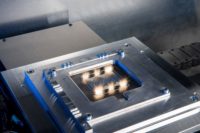LEIPZIG, Germany—BMW’s first cell coating line for EV battery manufacturing has begun operation at the carmaker’s assembly plant here.
By 2024, the two existing battery module assembly lines will be complemented by a third, as well as four more cell coating lines and two more high-voltage battery assembly lines. The four coating lines will enter series operation during the course of this year at roughly two-month intervals.
“From 2024 our plant…will be able to run the entire process chain for high-voltage battery production,” says Markus Fallböhmer, head of battery production for BMW.
To meet its goal of fully electric vehicles accounting for at least half of all sales by 2030, BMW is investing more than 800 million euros to establish e-component production at the Leipzig assembly plant.
Covering 2,300 square meters, the new cell coating system is located in the former production hall of the BMW i3, where production was phased out in the summer of last year. The space was then converted for e-component manufacturing in less than six months.
The new coating line can handle more than 10 million cells a year, or more than 2,300 an hour. The coated cells are then used on the battery module production line in Leipzig, to make modules for the fully electric BMW i4 and BMW iX1. A further line at the facility is producing battery modules for the BMW iX.
High-voltage battery production happens in three stages: cell coating, module production and assembly of the battery itself. The processes are highly automated.
BMW sources its cells from partners. The type that is used depends on the vehicle.
Coating lithium-ion cells consists first of pre-treating and patterning their surfaces with a laser. This involves the laser beam “chiseling” a texture into the outside of the uncoated cell to increase both its surface area and the surface tension of the aluminum casing. Next, the cells are plasma-cleansed to remove any dirt and oxides. Together, these two processes improve the adhesiveness of the surface.
The coating is administered by a specially developed machine that coats the cells in two layers, which are then hardened by UV radiation and offer the best possible insulation for the cells. Finally, a fully automated three-stage quality control process is carried out in which the thickness and surface quality of the coating are inspected. A high-voltage test is conducted to ensure the coating is free from defects.
Once coated, the battery cells are assembled into larger units known as modules. When completed, these are fitted into an aluminum housing along with the control and cooling units and the connectors that will connect them to the vehicle. The size and shape of the housing and the number of modules inside depends on the vehicle.
The continued expansion of the Leipzig plant will be driven by e-component production, which will take up some 150,000 square meters of manufacturing space in the future.
“This is a long-term investment in the future of the Leipzig plant,” says plant director Petra Peterhänsel. “At present, more than 800 employees work in e-component production at our Leipzig site. By 2024 there will be more than 1,000.”
The next milestone for the plant will be production of the MINI Countryman successor, which will roll off production lines at the end of this year. The crossover will be available with a choice of combustion engines or a fully electric drive powered by high-voltage batteries made in Leipzig.

